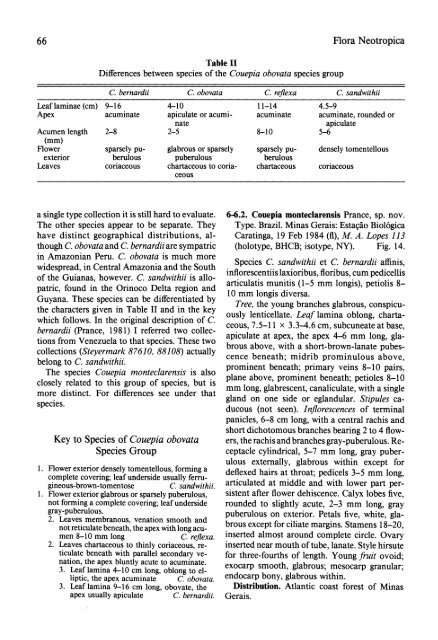flora neotropica - CNCFlora
flora neotropica - CNCFlora
flora neotropica - CNCFlora
Create successful ePaper yourself
Turn your PDF publications into a flip-book with our unique Google optimized e-Paper software.
66 Flora Neotropica<br />
Table II<br />
Differences between species of the Couepia obovata species group<br />
C. bernardii C. obovata C. reflexa C. sandwithii<br />
Leaf laminae (cm) 9-16<br />
Apex acuminate<br />
Acumen length 2-8<br />
4-10<br />
apiculate or acuminate<br />
2-5<br />
11-14<br />
acuminate<br />
8-10<br />
4.5-9<br />
acuminate, rounded or<br />
apiculate<br />
5-6<br />
(mm)<br />
Flower<br />
exterior<br />
Leaves<br />
sparsely puberulous<br />
coriaceous<br />
glabrous or sparsely<br />
puberulous<br />
chartaceous to coriaceous<br />
sparsely puberulous<br />
chartaceous<br />
densely tomentellous<br />
coriaceous<br />
a single type collection it is still hard to evaluate. 6-6.2. Couepia monteclarensis Prance, sp. nov.<br />
The other species appear to be separate. They Type. Brazil. Minas Gerais: Estagao Biologica<br />
have distinct geographical distributions, al- Caratinga, 19 Feb 1984 (fl), M. A. Lopes 113<br />
though C. obovata and C. bernardii are sympatric (holotype, BHCB; isotype, NY). Fig. 14.<br />
in Amazonian Peru. C. obovata is much more<br />
widespread, in Central Amazonia and the South<br />
Species C. sandwithii et C. bernardii affinis,<br />
inflorescentiis<br />
of the Guianas, however. C. sandwithii is allolaxioribus,<br />
floribus, cum pedicellis<br />
articulatis munitis<br />
patric, found in the Orinoco Delta region and<br />
(1-5 mm longis), petiolis 8-<br />
10 mm<br />
Guyana. These species can be differentiated<br />
longis diversa.<br />
by<br />
the characters given in Table II and in the<br />
Tree, the young branches glabrous, conspicukey<br />
which follows. In the original description of C.<br />
ously lenticellate. Leaf lamina oblong, chartabernardii<br />
(Prance, 1981) I referred two collecceous,<br />
7.5-11 x 3.3-4.6 cm, subcuneate at base,<br />
tions from Venezuela to that species. These two<br />
apiculate at apex, the apex 4-6 mm long, glabrous<br />
collections<br />
above, with a short-brown-lanate<br />
(Steyermark 87610,<br />
pubes-<br />
88108) actually cence<br />
belong to C. sandwithii.<br />
beneath; midrib prominulous above,<br />
The species Couepia monteclarensis is also<br />
prominent beneath; primary veins 8-10 pairs,<br />
closely related to this group of species, but is<br />
plane above, prominent beneath; petioles 8-10<br />
mm<br />
more distinct. For differences see under that long, glabrescent, canaliculate, with a single<br />
gland on one side or eglandular. Stipules caspecies.<br />
ducous (not seen). Inflorescences of terminal<br />
panicles, 6-8 cm long, with a central rachis and<br />
short dichotomous branches bearing 2 to 4 flow-<br />
Key to Species of Couepia obovata ers, the rachis and branches gray-puberulous. Re-<br />
Species Group<br />
ceptacle cylindrical, 5-7 mm long, gray puberulous<br />
externally, glabrous within except for<br />
1. Flower exterior densely tomentellous, forming a deflexed hairs at<br />
complete covering; leaf underside usually ferru-<br />
throat; pedicels 3-5 mm long,<br />
gineous-brown-tomentose C. sandwithii. articulated at middle and with lower part per-<br />
1. Flower exterior glabrous or sparsely puberulous, sistent after flower dehiscence. Calyx lobes five,<br />
not forming a complete covering; leaf underside rounded to slightly acute, 2-3 mm long, gray<br />
gray-puberulous.<br />
2.<br />
puberulous on exterior. Petals<br />
Leaves membranous, venation smooth and<br />
five, white, glanot<br />
reticulate beneath, the apex with long acubrous<br />
except for ciliate margins. Stamens 18-20,<br />
men 8-10 mm long<br />
C. reflexa. inserted almost around complete circle. Ovary<br />
2. Leaves chartaceous to thinly coriaceous, re- inserted near mouth of tube, lanate. Style hirsute<br />
ticulate beneath with parallel secondary ve- for three-fourths of<br />
nation, the<br />
length. Young fruit ovoid;<br />
apex bluntly acute to acuminate.<br />
3. Leaf lamina 4-10 cm long, oblong to el- exocarp smooth, glabrous; mesocarp granular;<br />
liptic, the apex acuminate C. obovata. endocarp bony, glabrous within.<br />
3. Leaf lamina 9-16 cm long, obovate, the Distribution. Atlantic coast forest of Minas<br />
apex usually apiculate C. bernardii. Gerais.

















